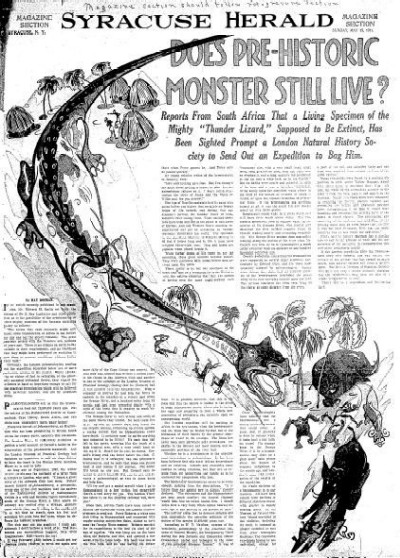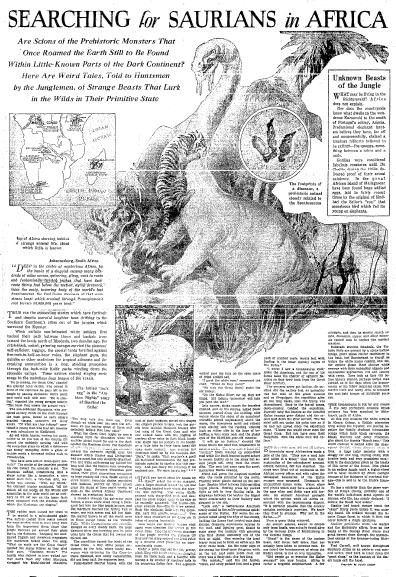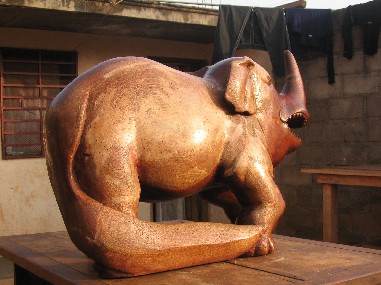Africa’s Art Deco Dino: Njago Gunda
Posted by: Loren Coleman on October 27th, 2007

Syracuse Herald, May 15, 1921
In 1920, the Smithsonian Institution sent a 32-person expedition to Africa, which found unexplained tracks along the riverbank and heard mysterious “roars.” See the “Dinosauria” chapter of my field guide for more details.
One hundred years ago, people would grab their weekend newspapers and hurry to find the Sunday supplements. There they might discover new adventures of explorers in deepest darkest Africa, follow the treks of famed safari leaders, and learn of new animals being found in the jungles. Take a moment today, reach back to that feeling, understand the world is not fully explored, and read this weekend of a cryptid described from then that might still be out there, waiting to be discovered.
Writers a century ago admittedly were being slightly racist in their articles, for they were merely reflective of a time in which their awareness for such matters lagged far behind where it should have been. Dive to the depths of the data here, realizing the article’s shortcomings in sensationalism and lack of political correctness need not get in the way of transmitting a flavor of the times and some facts on the Njago Gunda.
Enjoy.
Copyright: Michel Ballot Cameroun 2004
Native art of the Emela-ntouka, the possible new subspecies or species of aquatic rhinoceros in the Cameroon-Congo area. The Emela-ntouka is not the Njago Gunda or the Mokélé-Mbembé, but perhaps a piece of local art exists out there showing the Njago Gunda?
Click on image for larger size
Njago Gunda, Native of Africa: Will Roosevelt Find Strange Animal?
Prof. R. L. Garner, the Famous African Traveler, Describes the Strange Beast That Has Terrified the Natives in the Dark Continent.
Far away in the depths of the great forest of Africa there are, no doubt, many strange forms of life, both animal and vegetable, that are yet unknown to the outside world. From time to time new types of both kingdoms are discovered and made known to science; but that vast extent and wild character of the regions yet unexplored justify the hope that future discovery may add many new links to the chain of life.
Only a short distance south of the equator and not far from the western seacoast of Africa is a large lake commonly known to geography as Lake Fernan Vaz, but in the native tongue is called Eliwa Nkami. It is fed by several streams flowing from the south and east of it, including the southern branch of the Ogowe river, and has its outlet at the bar of Fernas Vez.
In its general outline Eliwa Nkami somewhat resembles a Gothic L. Its total length is some fifty miles, and its width varies from a mile or so to eight or nine.
In the midst of all this wealth of beauty the great lake spreads out its amber waters over many a dead man’s bones, and unseen danger lurks in every nook. This charming lake is one of the favorite haunts of fierce amphibians.
In many places schools of hippopotami may be seen at any hour of the day. [To] those who frequent the lake in their canoes those places are well known and easily avoided, but those ugly beasts roam about under the surface of the water and are often encountered at most unexpected places. With little or no provocation they often attack and sometimes destroy canoes and all their occupants.
Crocodiles also infest these waters, and while they do not attack canoes, they are liable at any time to attack a man who gets into the water. There are also sharks of the smaller kind and a variety of other fishes that will attack anything that comes within their domain.
The people who occupy the basin of this lake are known as the Nkamis. They are not one of the largest tribes of Africa, but are a people of average native intelligence, and perhaps more than average cleverness in adopting the manners of the few white people who come among them.
They were formerly one of the chief slave-trading tribes of the coast, and many of the black people of America are descendants of them or of contiguous tribes upon whom they once carried on perpetual war in order to capture prisoners to sell to the white slavers who came to this section to buy them. Many traces of the old stockades are still visible along the coast.
As far back into the past of the memory of the oldest men and women of this tribe can go, there have been, and still are, current among the people authentic accounts of a strange monster of gigantic proportions and of great ferocity inhabiting the deep waters and dismal marshes of the lake. It has been frequently and recently seen by many living witnesses, and many deaths of natives caused by it testifying to its reality.
Numbers of canoes have been smashed into splinters by it, and scores of human victims are charged to it. For some months in succession it has loitered about the mouth of the [illegible] creek, a deep inlet of the lake, where it attacked or chased every canoe that came near its haunts, resulting in the total ruin of many canoes and the cost of more than twenty lives.
In the native language the animal in question is called njago gunda. The former term is the vernacular for elephant in its generic sense, and is applied as such to the two distinct species that inhabit the forests and plains of this region and both of which are well known to the native hunters. The latter term, gunda, is the specific name of that part of the exoskeleton which develops in the form of coarse, wire-like bristles, of
horn-like texture, which grow at the end of the tail of all elephants.In its use in this instance, however, it is not only intended to describe these as a marked characteristic of the animal, but it is meant to imply something of his frightful appearance by reason of the unusual abundance and great size of them and their peculiar distribution.
All accounts agree that njago gunda is more than twice as large as an adult male elephant of the ordinary kind. It is somewhat darker in color and much more active and rapid in its movements. Its proboscis is only a little more than half the length of its head, and near the base of it is an oval hole on each side resembling nostrils. Their functions are not positively known, but they are believed to be valves through [which] water is drawn into the nasal cavity and ejected through the proboscis.
The ears are comparatively small and pointed. Above each eye and obliquely above each nostril or valve is an enormous fan-shaped tuft of those stiff bristles, or ngunda, more than a foot in length, the longest of them possibly eighteen inches. Along each side of the proboscis is a thickly set row of them, somewhat shorter than those elsewhere about the face. From the upper edge and point of each ear projects an array of them and from the frontal prominence along the sagittal and as far as has been seen along the spine is a dense row of them even much larger than those about the face.
Njago gunda is not only a creature of horrid aspect; he is quite as ferocious as he looks to be, and is very justly regarded by the natives as the chief terror of the lake. Without the slightest provocation he fiercely attacks anything that approaches him. In so doing he suddenly ejects those tufts and rows of hard black bristles, rears his head and proboscis above the surface of the water, and with a long, piercing shriek rushes like a comet upon his helpless prey.
When he comes within eight or ten yards of the object of his attack, he jets from his short, thick proboscis a terrific stream of water with the force of a fire-plug. In this manner he instantly capsizes or swamps a canoe and stuns or stifles its occupants. Without pausing for an instant he presses the attack, and with rapid strokes of his deadly proboscis he crushes everything in reach.
The volume of water thrown by njago gunda is said to be as thick as the arm of a man and sent with force enough to kill a man at a distance of four or five yards. In the native language it is called “mbuma ‘nengo,” meaning “rainbow of water.”
The bristles act in concert, and during the assault the fiend causes them to rise and fall with rapidity, furiously lashing his hard skin and causing a wierd [sic], swishing sound which chills the courage of the bravest of men.
Not long since a convoy of four canoes coming down the Rembo Nkami was attacked by one of these monsters. Every canoe was smashed into fragments, and nine out of fourteen people in them have never since been seen or heard of.
The catastrophe occurred near a bank of the river, and five men thereby escaped and made their way by separate routes through the bush to a native village. Stray bits of the wrecked canoes were afterward found along the sides of the river, but no trace of the nine victims, of whom two were women, was ever found.
In all essential points the accounts given by the survivors sufficiently agree, but the minor details are not enough like to warrant the suspicion of a concocted story and the separate versions of this incident, as given by these five men, not only coincide with each other, but the fundamental facts concur with the reports of the few survivors and witnesses of similar attacks of the brute made elsewhere.
Some years ago one of these animals was found dead in a deep morass near the mouth of the Rembo Nkami. No one knew the cause or time of its death. It was only discovered by the smell, and no native would venture near it. It lay there and decayed, and the bones are possibly there to this day; but no native of this country could be induced to search for them or to touch one of them, if found, because the animal is regarded as mbuiri, or fetish.
There are plenty of people now living [in] the vicinity who ventured near enough to get a partial view of the carcass, but not one of them will go near the spot where it perished, and the price of a kingdom would not induce any one to dig in the marsh for the skeleton.
The general belief, however, among those who know most about the animals is that they are exceedingly rare, and only a very few at most have ever been seen in the lake of its environs. It is definitely known that four or five different ones have been seen, only one of which is thought to be a female. Not one has ever appeared during the dry season, and it is very exceptional that one is seen when it is not actually raining.
During a period of more than twelve years and a resident of more than two years among the Nkamis I have made the most searching inquiries that I am capable of, and I am finally persuaded that there is a foundation of truth upon which the story of the njago gunda rests.
The matter-of-fact manner in which accounts of the beast are narrated and received, and all these separate witnesses, without rehearsal or previous consultation, concur in the main facts both as to the appearance and conduct of the monster. It has been seen by more than two scores of people at the same time, and at different times and places by many hundreds, all of whom give similar, though not identical, accounts of it.
It may be much smaller in size and much less ferocious than it has been described to be, but that it is some rare beast of peculiar form and frightful aspect there is little or no reason to doubt. Whether it ultimately proves to be some new species of pachyderm, as it is now believed to be, some strange cretacian [sic], as it is more likely to be, or some reptilian novelty, as it is possible to be, cannot be determined from the meager data now available.Written Especially for the New York World by R. L. Gardner, carried in the Fort Wayne [Indiana] Journal-Gazette, June 13, 1909.
Thanks for this 1909 historical item from Jerome Clark.

Fresno Bee, February 19, 1928
Thanks to Craig Heinselman for the 1921 and 1928 scans.
About Loren Coleman
Loren Coleman is one of the world’s leading cryptozoologists, some say “the” leading living cryptozoologist. Certainly, he is acknowledged as the current living American researcher and writer who has most popularized cryptozoology in the late 20th and early 21st centuries.
Starting his fieldwork and investigations in 1960, after traveling and trekking extensively in pursuit of cryptozoological mysteries, Coleman began writing to share his experiences in 1969. An honorary member of Ivan T. Sanderson’s Society for the Investigation of the Unexplained in the 1970s, Coleman has been bestowed with similar honorary memberships of the North Idaho College Cryptozoology Club in 1983, and in subsequent years, that of the British Columbia Scientific Cryptozoology Club, CryptoSafari International, and other international organizations. He was also a Life Member and Benefactor of the International Society of Cryptozoology (now-defunct).
Loren Coleman’s daily blog, as a member of the Cryptomundo Team, served as an ongoing avenue of communication for the ever-growing body of cryptozoo news from 2005 through 2013. He returned as an infrequent contributor beginning Halloween week of 2015.
Coleman is the founder in 2003, and current director of the International Cryptozoology Museum in Portland, Maine.











hey loren, very interesting new article about africa s art deco dino: njago gunda. thanks bill green 🙂
Definitely very interesting. I don’t doubt that there are many strange undiscovered creatures- including the possibility of dinosaurs- in the depths of these jungles.
If we regularly discover new species in areas that are frequently explored, I can only imagine what lurks in these vast, deep jungles that aren’t explored.
/gets excited at the increasing possibility she can have her own pet Dimetrodon someday! haha….. :-p
I like the drawing of the tiger attacking the dinosaur on the article. Forgive me if I’m wrong, but I always thought tigers were residents of Asia and not Africa…
I see a lot of room for fabulizing when it comes to the Dark Continent, and else where. Never the less, the sad fact is that guns and commercial hunting prededing biologists in every unbroken wilderness on the planet with the possible exception of mainland Antarctica, probably because it was too hard to get to and not enough (none) terrestrial animals of economic interests. Could this have wiped out small vestigal populations in the occasional refugia? I think so and it’s only our current conservative understanding of what the pre-modern human landscape was that obscures the reality.
Jaded1 is right. There are no tigers in Africa. Plus, tigers (and more or less any predators) would never attack alone a prey like this, bigger and stronger than it is… Except maybe to protect its offspring. This illustration looks as the article sounds: made to fit the Sunday supplements readers dreaming.
Don’t forget that newspapers were the big media of this era, and to keep their readers they were already competing as “fiercely” as they do today.
As Loren suggets, it’s for Sunday. Happy Halloween!